Schindler’s List, Inglourious Basterds: Cementing and Reclaiming History in Cinema
The Second World War has long been the playground of cinema. From documentaries to action-adventure romps, we have seen all the turmoil and conflict of the largest war the world has ever seen portrayed in all manner of different ways, with a few noticeable exceptions.
Films covering the holocaust have often been left out of the Hollywood canon, whether because of the difficulty involved in portraying such an event or the fears of a bad box office reaction from audiences, with representation from major studios being lacklustre at best.
The fear of artistic contemplation around cinema’s own often sordid history with World War 2 has also been ripe, but two very contemporary and unique directors have been able to do justice to these events and right the wrongs of film history: Steven Spielberg and Quentin Tarantino.
Schindler’s List
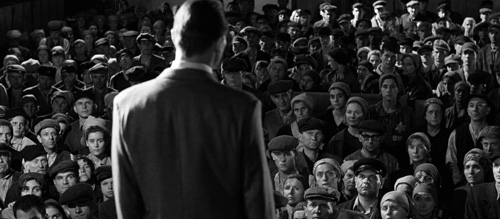
Steven Spielberg had set out to adapt Thomas Keneally’s “Schindler’s Ark” in 1983, ten years before Schindler’s List’s release. There had been previous attempts to adapt the story of Oskar Schindler, played in the film by Liam Neeson, as far back as 1963, but studios had been afraid to adopt the project.
As one of the frontrunners in the New Hollywood movement, Steven Spielberg had never been afraid to push the studio system into new forms of filmmaking, and coming off the back of the Indiana Jones trilogy and Empire of the Sun, he was able to guarantee box office success for the often-rapacious studios.
The film was finally greenlit in 1992, after swapping hands between Spielberg and Martin Scorsese, and saw the big-time director working with a much smaller budget than he was used to; $22 million in comparison to the $70 million of his previous film Hook. The film follows Oskar Schindler as he grows increasingly concerned for his Jewish workforce during the rise and fall of the Nazi regime.
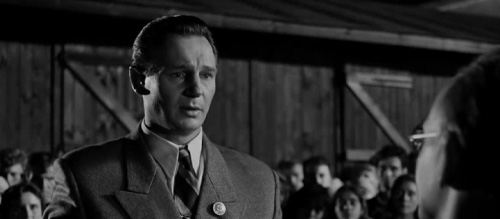
Liam Neeson’s Oskar Schindler begins Schindler’s List as an industrialist and member of the Nazi party, and it’s only when his Jewish foreman Itzhak Stern (Ben Kingsley) approaches him to help other prisoners that he begins to act, realising that his privileged position has separated him from the utter horror that those around him experience.
Only from European directors had there been films about the Holocaust that dealt with the emotional reality with the kind of surgical approach required for such a subject – specifically Alain Resnais’ powerful documentary Night and Fog – but these never had the wide populist appeal of any American production. Spielberg, influenced heavily by French New Wave directors like Resnais, would set out to bring this story of profound emotion and cruelty to the screens of average movie goers.
Steven Spielberg is of Jewish upbringing and descent, with his family taking a major role in local religious organisations during his youth. Spielberg has stated that the Holocaust was often discussed by his parents, with his father losing sixteen family members due to the atrocity.
Schindler’s List opens with a candle shedding light into a darkened room, as Spielberg prepares to illuminate a part of history often mishandled. Janusz Kaminski’s black and white photography is stylised yet elegant, with long shadows and deep rays of light picking out the violence and characters in a sea of faces. The visual power never overstates or understates the human suffering at the heart of the narrative. This is best utilised later in the film as a group of Nazi soldiers storm through the ghetto that has imprisoned many of Schindler’s Jewish workers. The camera follows them in an almost documentarian style, situating us initially with the perpetrators. This footage is eerily similar to the films of the concentration camps captured by the victorious allies; not just the use of black and white photography but also the handheld camera that emphasises events over cinematic style. What follows is a montage of brutality and fear as the Jewish prisoners attempt to hide but are found and killed one by one.
Presenting these moments with such cool restraint only emphasises the fear and human experience of each of the people we follow. We know them only momentarily, but their emotions and fear are justified by seeing the power of the force that pursues them. When we finally cut to a wide shot of Schindler looking down on the violence below, we are given a moment to breathe and absorb the horror we just witnessed others experience. The visuals are used with great power to emphasise moments of fear, of hope and of sorrow, in much the same way that Spielberg has built his career. He is known for his power over schmaltz and his big emotional beats, but of all the pieces directed by Steven Spielberg this is probably the most emotionally sensitive. In Schindler’s List, this great American director charts his way through every possible feeling he can rinse from a film like this and does it in a way that never feels manipulative, cheap or too overt.
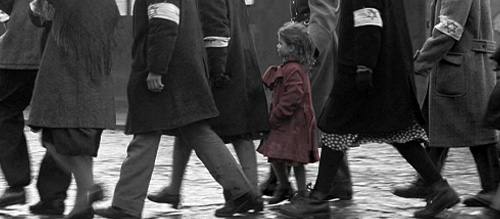
The girl in the red coat, probably Schindler’s List’s most iconic image, is a pin prick of light in the severity of it all. Her initial appearance is in line with Spielberg’s sparing use of colour, applying it to portray hope and salvation amongst the conflict and suffering. When she appears for the final time, brutalised and destroyed, Schindler finally decides what he must do. This piece of cinema is so powerful that it’s worth marvelling at. It is no coincidence that Schindler only begins to act when Stern brings forward some refugees that he has the power to protect; bringing the individual stories of survivors to the forefront is the only way to understand such an event.
In line with the stories of individual victims is the film’s strong emphasis on names. From the opening montage to the closing shot we are continuously reminded of the names of the victims of these events. This feels like a response to a scene in the film that sees Amon Göth (Ralph Fiennes), the commanding officer of a Nazi internment camp, proclaim to the guards that the history of the Jews is now eradicated, of course an important tactic in Nazi oppression. As the film progresses, and Göth’s tactics become more severe, the destruction of identity becomes an important through line. The Jewish prisoners are degraded and stripped of personal possessions, making them less than human in the eyes of the Nazis. Spielberg does not want the audience to forget this piece of history and is intent on using his cinematic form to engrain it in art. The names of these people are as important as the event itself; they sit at the film’s core – they are never hidden under overt stylisation and big emotional moments. There’s also an awareness of the context of the film itself; produced by a large American studio, with a cast helmed by non-Jewish actors and an American director. A production like this could have easily erased the names of those victims in an act of profit-motivated ignorance, but by making them a central narrative and thematic point they become unmissable. The film’s final scene sees the remaining survivors paying respect to Schindler at his grave, accompanied by family or those who portrayed them in the film, each life saved is represented and so are their stories.
Simply having the name “Spielberg” attached to this film would have immediately placed it in the cinematic pantheon, but the film surpassed even its director’s filmography. At the 1994 Oscars it received 7 Academy Awards, including Best Picture and Best Director. The overall critical response was immensely positive, with the likes of Roger Ebert describing it as one of the best films of 1993. It also earned a $300million profit at the box office and is considered one of the greatest films of all time. Schindler’s List has cemented itself in the cinematic ecosystem as a reference point for quality filmmaking and storytelling, thus placing a clear and survivor-driven narrative at cinema’s forefront. There is a comfort in knowing that a piece of popular cinema represents this moment in history to the best of its ability.
Inglourious Basterds
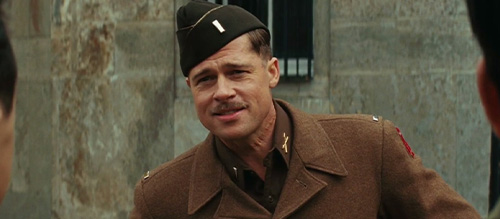
Where Steven Spielberg filled a black spot in cinema’s history with his presentation of the atrocities of the holocaust, Quentin Tarantino intended to rewrite it.
Following the critical and monetary failure of Death Proof, and the whole Grindhouse project, Tarantino decided to take an introspective look at one of the genres that most inspired him: war. Inglourious Basterds is a rework of the team-up war films of his youth, and the ones that Hollywood long preferred to films like Schindler’s List. Tarantino had been playing around with the script for the film for over a decade before production, considering it his masterpiece. The story had taken many different forms, at one point being a mini-series, but he later settled on a more constrained version of the film. Shooting began in 2008.
Inglourious Basterds follows a group of American soldiers sent behind enemy lines to enact violent retribution on the Nazi army. During a screening of a Nazi propaganda film, the tactfully named Basterds plan to murder the whole Nazi high command in one sweep, but they are unaware that the Jewish cinema owner Shosanna (Mélanie Laurent) has a similar if slightly more theatrical plan.
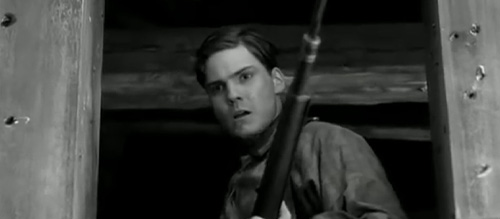
The propaganda film in question is Nation’s Pride, which was made specifically for the film by Basterds cast member (and prominent director in his own right) Eli Roth. The film follows Daniel Brühl’s Frederick Zoller as he fights off wave after wave of American soldiers in an act of fascistic heroism. This film itself is an exercise in cinematic retribution, ripping the power of film from the hands of the Nazis. In terms of the violence of Zoller’s actions, it is more subdued and sober, adding a realist brutality to its impact. This is in direct contrast to the cathartic “movie violence” Tarantino implements against the Nazis. The violence is on the side of the good guys – there is to be no morbid satisfaction in seeing Zoller’s’ actions play out.
Nation’s Pride is more influenced by the Soviet propaganda film Battleship Potemkin, from the snap zooms on a blinded soldier to the general style. This is an attempt by Tarantino and Roth to separate this film from the stylistic proclivities of actual Nazi filmmakers like Leni Riefenstahl, refusing to bring their filmmaking into a 21st Century context. Riefenstahl and other filmmakers like G.W Pabst are referenced throughout the film, but never portrayed. The mere influence of Battleship Potemkin sees that moment in cinema history revisited and reclaimed in an act of sheer stylistic control.
Zoller is both a representation of a literal fascistic use of film (reliving his heroic actions for the silver screen) and of film knowledge. He is a continually lonely cinephile who in finding that Shosanna is the same becomes immediately besotted. Zoller sits in the film opposite another character with a similar knowledge but with a much more positive application – Michael Fassbender’s Lieutenant Hicox. Hicox is recruited to help the Basterds in their assassination of the Nazi high command because of his knowledge of film and his career as a critic, and although Hicox’s mistake does lead to a significant change of plan, it is not one made out of spite but out of naivety. These two characters are representations of not just a misuse of film but of film knowledge. Zoller uses an uncritical love of cinema to support its use as fascist propaganda, where Hicox uses his knowledge in opposition to the misuse of the artform. Both are naïve in their own ways to the execution of both the plan and cinema as a whole, but they are nonetheless important to the life of the artform. Hicox’s place as a critic is important to the team, thus important to cinema, and though Tarantino is aware that critics may not always be privy to the ins and outs of filmmaking, in this case represented by Hicox’s incorrect hand signal, they are still important to the outcome. The power of cinema doesn’t just lie in the hands of the filmmakers themselves, but also how cinema lovers interact with and interpret the medium.
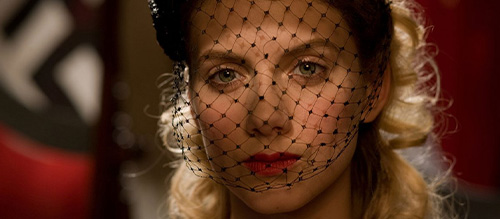
As Nation’s Pride is shown to a room full of the most evil people on the planet, Shosanna sets in motion her plan. Locking the doors to the theatre she sets fire to a pile of 35mm film which, as Tarantino helpfully informs us, is incredibly flammable. A glorious fire explodes from the screen and, as it engulfs the room and the Basterds set to work with their own explosive show, Shosanna’s face is projected into the haze of smoke from her burning film. Even after Zoller has enacted lustful revenge on her, she remains forever immortalised on celluloid. It wasn’t the Basterds who brought down the Third Reich, it was a Jewish cinema owner. The very literal use of film to destroy the Nazis does not need pointing out.
Inglourious Basterds is also an example of Quentin Tarantino’s use of historical revisionism. This is a narrative tool he has fully embraced in his later career, with The Hateful Eight and Once Upon a Time… In Hollywood both adopting it to greater and lesser degrees. This is also weaponised against Christoph Waltz’s brilliantly acted Hans Landa, a character so villainous that he’s comical. Unlike many Nazis who found themselves free after the war by escaping the authorities or by joining them, Landa is permanently marked by Aldo Raine (Brad Pitt), the leader of the Basterds, in an act that enshrines his crimes for the rest of his days. The Swastika carved, with great skill, into Landa’s head, is Tarantino forever branding a part of cinema history for the misuse of its power.
Tarantino’s self-proclaimed masterpiece is a representation of his own cinema history, as well as our own, a culmination of all of his directorial and genre influences as well as the best portrayal of his own unique abilities. The control he has over the tension that he can drain from a simple conversation or character moment, his quippy dialogue, visual grandeur, use of music, and of course his ego. The final line paired with the cut to credits might be the funniest and most pompous thing Tarantino has ever done.
Recommended for you: It Might Be His Masterpiece: Revisiting Tarantino’s ‘Inglourious Basterds’
Basterds is often considered one of Tarantino’s best, taking the place of Pulp Fiction as his most popular and receiving $320million at the box office. The film received an 11-minute standing ovation at the Cannes film festival, and although some critics saw it as immature and self-indulgent, the audience reception was extremely positive. The director himself considers it his best film, with the opening scene being the greatest thing he has ever written. Tarantino has managed to bring his nerdy, stylistic, and occasionally obnoxious form of filmmaking into the realm of popular cinema, and he remains one of the few directors who could be considered a household name. To bring a film about the misuse of the medium into the public consciousness with such flare and entertainment value is an impressive feat; one that has paid off as the film often sits close to Schindler’s List as one of the greatest war films ever made.
Conclusion
Both of these films, however dissimilar, understand that cinema itself is a historical document, and in its more popular forms can shape people’s views of the world. Schindler’s List is the use of an art form to lay down a factual and emotional event, bringing it into popular cinema and filling a long-neglected gap in the cinematic conscience. Inglourious Basterds does the same with cinema itself, setting out how this power can be abused, then attempting to rewrite fiction to reclaim that power. These films are both landmarks in cinema history – one is a monumental art film in the filmography of an establishment director and the other is a masterpiece from a director who has curated his own legacy. Both films are regarded as some the best of their respective decades, cementing their stories in the minds of each of us for all of time itself. They encapsulate cinema in all its hideousness and brilliance, and they prove that cinematic conventions and a populist approaches can deal with such horrific events with subtlety and introspection. Schindler’s List and Inglourious Basterds are exercises in pure cinematic power.
By Robert Mitchell

